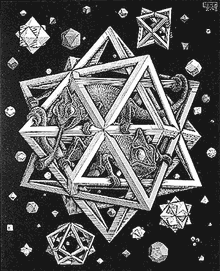
Those are hot young stars in the Large Magellanic Cloud—one of the puppy-dog galaxies that follow the Milky Way around—photographed by the Hubble Space Telescope. (Detail cropped from a Wikipedia image.) Note that four rays seem to emanate from each of the brightest stars. The rays are not, of course, true beams of light radiating in the four cardinal directions. They are an artifact of the telescope’s structure: a diffraction pattern created by the four vanes of the “spider” that supports the secondary mirror within the barrel of the telescope. Many other telescopes have three-vane spiders that yield a six-pointed diffraction pattern.
 Recently, in my lovable know-it-all manner, I was holding forth on the idea that this diffraction effect—a mere accident of instrumental design—might actually be the source of the familiar iconographic star, with its five or six angular points. In other words, we think of a star as something spiky, poking out in various directions, because we’re used to seeing telescopic images with this diffractive defect. At right is M. C. Escher’s interpretation of what stellar means. For other examples see the Hollywood Walk of Fame or the flags of the U.S. and the E.U. and those of more than 50 other countries, not to mention Texas.
Recently, in my lovable know-it-all manner, I was holding forth on the idea that this diffraction effect—a mere accident of instrumental design—might actually be the source of the familiar iconographic star, with its five or six angular points. In other words, we think of a star as something spiky, poking out in various directions, because we’re used to seeing telescopic images with this diffractive defect. At right is M. C. Escher’s interpretation of what stellar means. For other examples see the Hollywood Walk of Fame or the flags of the U.S. and the E.U. and those of more than 50 other countries, not to mention Texas.
Well, it turns out my cute idea about the cultural influence of telescopic photos is utterly bogus. If you need any evidence, the engraving reproduced below should suffice. It shows the muse Astronomia (a.k.a. Urania) pointing out the moon and stars to Ptolemy. The stars are five- or six-pointed scribbles that beg to be called asterisks. The engraving appears in the Margarita Philosophica of Gregor Reisch, published in 1504, which is a full century before Galileo turned his telescope to the heavens. Whatever those engraved stars are, they are not artifacts of telescope spider vanes.

The dictionary offers further evidence. For example, the starfish (genus Asterias, class Asteroidea) has had that name at least since 1538. And the asterisk—the typographical mark—has a citation in the OED going all the way back to 1382. These terms make sense only if the concept of a star was already associated in most people’s minds with a spiky polygon, rather than a dimensionless point of light in the night sky.
And that’s what puzzles me, because the stars really do appear to be dimensionless points of light. When I stare at the sky, I see some twinkling going on, but nowhere do I see pentagrams and hexagrams pinned to black velvet, or even the slightest hint of angularity. So where did this tradition get started? Did the Greek word ?????? already convey a sense of symmetrical spikiness, so that ancient Athenians would have understood why we call certain flowers asters? Is the same iconography prevalent in other cultures, say in China? Those 50+ star-studded flags (including China’s) suggest that the conventional stellar icon is at least recognized globally, but they don’t tell us where and when it all began. After my telescopic theory fell apart, I had a second hypothesis, namely that the star icon might come from the symbol-happy world of astrology, but I’ve found no support for this idea either. So I throw the question out to the starry void: How did the star get its points?
Addendum 2011-12-16: The illuminating comments below on ancient Egyptian paintings of stars would appear to settle part of my question: Well over 2,000 years ago, at least some people were already drawing stars in much the same way a modern kindergartner does. What I’d still like to know is why. Yes, there are many plausible just-so stories, but you’d think that someone at the time might have offered a word of explanation.
The other day I spent a pleasant afternoon leafing through The History and Practice of Ancient Astronomy, by James Evans (New York: Oxford University Press, 1998). It’s quite a thorough introduction to Greek and Egyptian ideas about the sky, but I did not find an answer to my question about the points of stars. The astronomers of that period were engrossed in charting the positions and motions of the stars, but one gets the impression they had no interest whatever in the nature of those bright objects—what they look like up close, what they’re made of, why they shine. Of course I don’t really believe the ancients were so lacking curiosity. Surely Aristotle holds forth somewhere on the substance of the stars? But I haven’t found it yet.